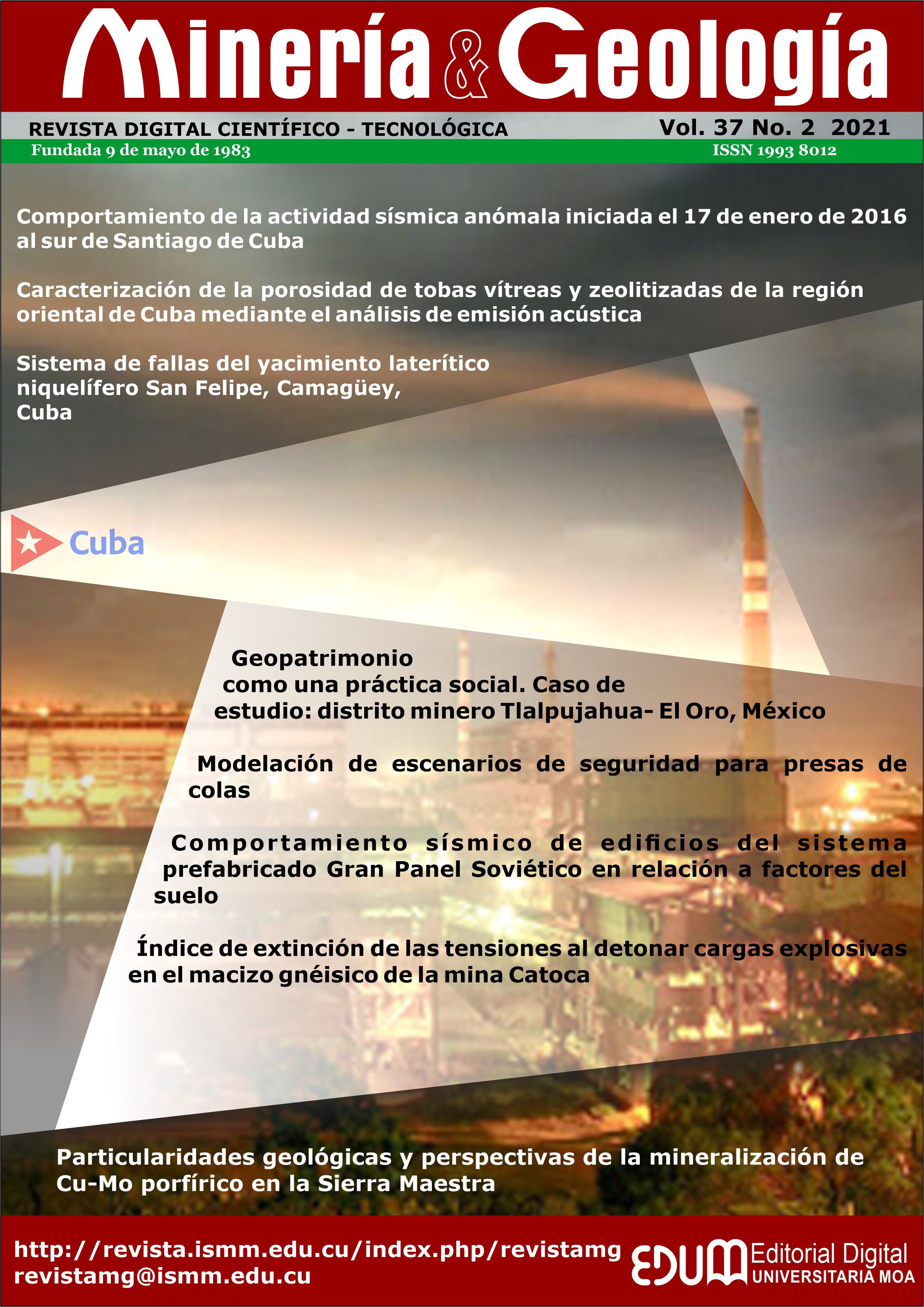Safety scenario modeling for tailings dams
Keywords:
tailings dam, risk management, modeling, safety scenarios.Abstract
Modeling safety scenarios for dams strengthens effectiveness of disaster risk management plans in this kind of work by reducing risk of failures that can cause considerable damage. The aim of the present paper was a proposal of a modeling methodology for safety scenarios in tailing dams from the Cuban nickel industry, to determine indicators and failure mechanisms, in order to achieve early detection risks and their reduction, as well as to minimize the negative impacts on the economy, the population, and the environment through a risk and disaster management plan.Downloads
References
De la Cruz-Fernández, S. 2017: Evaluación del fallo de presas de relaves con el método del árbol de fallos. Tesis de Maestría. Escuela Técnica Superior de Ingenieros de Minas y Energía. Madrid. 2017.
Foster, M., et al. 2000: A Method for Assessing the Relative Likelihood of Failure of Embankment Dams by Piping. Canadian Geotechnical Journal, 37(5): 1025-1061. http://dx.doi.org/10.1139/t00-029
Hernández, T. y Guardado, R. 2014a: Control de Erosión Mediante Bioingeniería en Presas de Colas de la Industria del Níquel. Minería y Geología, 30(4): 55-69.
Hernández, T. y Guardado, R. 2014b: Gestión de Riesgos por Deslizamientos en la presa de colas de la ECPSA. I Simposio de Minería y Medio Ambiente, Moa, Cuba.
Hernández-Columbié, T y Ulloa Carcasés, M. 2014: Impacto ambiental de la ampliación de una Presa de colas de la industria cubana del níquel. Minería y Geología, 30(3): 33-48
Hernández, T. 2015: Sistema de Gestión de Riesgos Por Fallos en la Presa de Colas de la Empresa Comandante Pedro Sotto Alba. Tesis Doctoral, ISMM, Moa, Cuba.
ICOLD., 2001: Talings dams risk of dangerous occurrences. Lessons learnt from practical experiences. Bulletin 121. Published by the International Commission on large dams, Paris. 1-144, (2001).
Kempena, A., Guardado, R., Hernández, T., y Viltres, Y., 2017: Cartografía de la peligrosidad por erosión hídrica en la ciudad de Brazzaville. Minería y Geología, 33(2): 144-162.
Martínez Silva, R., Hernández Columbié, T., y Chacón Pérez, Y., 2017: Método de Cálculo de Taludes por Estados Límites. Revista Avances, 19(3): 240-244.
Lavell, A., Cardona, O. y Mansilla, E. 2003: La gestión local del riesgo: nociones y precisiones en torno al concepto y la práctica. Centro de Coordinación para la Prevención de los Desastres Naturales en América Central (CEPREDENAC), PNUD. División de Medio Ambiente, Cambio Climático y Bioenergía. Roma.
Oldecop, L., y Rodríguez, L., 2007: Mecanismos de fallas de las presas de residuos mineros. Ingeniería Civil, 9: 148-181.
Pérez, G. 1996: Metodología de la investigación educacional. La Habana: Editorial Pueblo y Educación.
Villavicencio, G et al. 2013: Failure of sand tailings dams in a highly seismic country. Canadian Geotechnical Journal, 51(4): 449-464.
Published
How to Cite
Issue
Section
- Authors retain copyright and guaranteeing the right magazine to be the first publication of the work as licensed under a Creative Commons Attribution-NonCommercial that allows others to share the work with an acknowledgment of the work's authorship and initial publication in this journal.
- Authors may establish separate supplemental agreements for the exclusive distribution version of the work published in the journal (eg, place it in an institutional repository or publish it in a book), with an acknowledgment of its initial publication in this journal.
- Authors are allowed and recommended to disseminate their work through the Internet (e.g., in institutional telematic archives or on their websites) before and during the submission process, which can produce interesting exchanges and increase citations of the published work. (See The effect of open access)










